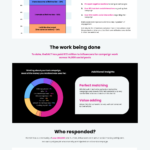By Pieter Groenewald, Nfnity Influencer, CEO
The UX on your Shopify store is seamless, your product offering is outstanding, but you’re not getting the clicks, traction or return on investment (ROI) on your monthly marketing spend. Almost every SME has been there, optimised that and, despite religiously paying for Google, Facebook and Instagram ads, still finds themselves under-target and on the opposite spectrum of ‘viral’.
Enter, the nano-influencer — the rising influencer who both markets (influences) and sells (via social commerce): the savvy tactic that every SME will adopt in a matter of time. The question is: Why not now?
More than 50 million people around the world consider themselves to be influencers (or creators). Influencer Marketing Hub estimates that the total creator economy market size is US$104 billion, and investments inside it totals US$5BN in 2022 alone. Despite some questioning the “authenticity” of social media influencers, the industry is booming and one need look no further than the runaway success of Prime Energy Drink’s launch by YouTubers Logan Paul and KSI for proof of its million-dollar potency. While not all brands can afford Logan Paul, each and every SME can benefit from influencer marketing and, most specifically, from nano-influencers. Here’s why:
Compared to a micro-influencer (who has 10,000-100,000 followers and are often considered experts in their fields), nano-influencers are “ordinary consumers” who share snippets of their day-to-day lives in less polished, more authentic content — including what they’ve bought, discovered and loved. Some may only have 1,000 followers but their impact and influence on consumer behaviour is significant, with sometimes even better engagement rates than mega-influencers or celebrities. It’s been proven, even in our latest survey, that working with nano-influencers can lead not only to increased brand awareness, sales and business growth, but it also offers a way to ignite trust and word of mouth marketing, at a bigger scale.
Take the work we did for one of South Africa’s largest furniture retailers, as a recent example. To meet the challenge of how a furniture giant drives sales and awareness of its large selection of couches and the ease of customisation online, we approached 10 nano-influencers — real customers — who consequently could bring across authenticity in their messaging. They created 43 pieces of user-generated content (UGC) on the retailer’s behalf. Through posts, stories and reels, they showed real-life, click-to-click examples of how easy it is to covet, upgrade and order the couch of your dreams. The proof was in the pudding: the campaign exceeded sales goals by over 200% and exceeded Return on Ad Spend (ROAS) by 6.9 times.
If you’re an SME and you’re not yet collaborating with nano-influencers, here are five reasons why you should be:
- SMEs can generate authentic messaging by engaging with nano-influencers
By engaging with nano-influencers, SMEs can create content that resonates with their target audience. With feeds that make followers feel like friends, nano-influencers post authentic, relatable content that is real, less polished, and more believable. As a result, these influencers act as trusted advocates, enabling SMEs to establish a genuine connection with potential customers. When SMEs partner with the right nano-influencers who align with their brand values and are loved by their target audience, the collaboration and influence can be powerful as they are able to tap into this otherwise inaccessible, authentic connection. At theSALT, this is what we do best: linking you to a nano-influencer who matches your existing brand fans.
- Start fresh conversations and boosted brand engagement with a new audience
Compared to bigger influencers and even celebrities, nano-influencers, with their smaller yet dedicated, hyper-loyal following, provide SMEs with an opportunity to foster meaningful interactions and conversations. For SMEs, this means that when a nano-influencer posts about, or reviews your brand, followers pay attention. This heightened engagement drives brand awareness and influences purchasing decisions among their audience.
- Build trust and credibility by leveraging real, trusted endorsements
When an influencer promotes a product or service, their followers perceive it as a genuine recommendation rather than an ad. By collaborating with nano-influencers, SMEs can tap into the trust they have built with their audience and therefore enhance their brand’s credibility, while attracting customers who are already interested in their offerings.
- For SMEs on a budget, nano-influencers are a cost-effective marketing channel
Unlike celebrities or macro-influencers, nano-influencers offer cost-effective collaborations for SMEs with limited marketing budgets. These partnerships often involve lower fees, product exchanges, or trade arrangements, allowing SMEs to leverage the influence of multiple nano-influencers within their budget constraints.
- SMEs can amplify their brand and its reach with nano-influencers
Any digital marketing guru will confirm that there is nothing more powerful nor persuasive on a brand’s feed than organic user generated content (UGC). It adds credibility and goes a step further by putting your brand into real-life hands and homes. SMEs can repurpose compelling UGC created by nano-influencers across various marketing channels, amplifying their brand’s message and maximizing its reach.
Regardless of the product or brand, partnering with the right nano-influencer with the right audience on the right platform can lead to great success — which, better still, you can measure. Through specific tracking links, discount codes, or affiliate marketing programs, it’s simple and easy to monitor the real-time performance of your collaboration with a nano-influencer and evaluate the bang for your marketing buck.
In my experience, I have learnt that there is something priceless about forging a genuine relationship with a nano-influencer who is fully aligned with your brand and its values. When this happens, it can lead to everything a brand wants and needs to achieve online: increased visibility, which leads to brand recognition, improved search engine rankings and, ultimately, more organic traffic and clicks to checkout. Better than a social ad? I’d bet on it.
- HubSpot names Zuper an Essential App for Customer Service in 2024 - 25th April 2024
- How AI, Automation, and Trusted Data are shaping Next-Gen Customer Service - 25th April 2024
- UJ & Razor PR partner to reshape communication skills - 23rd April 2024






